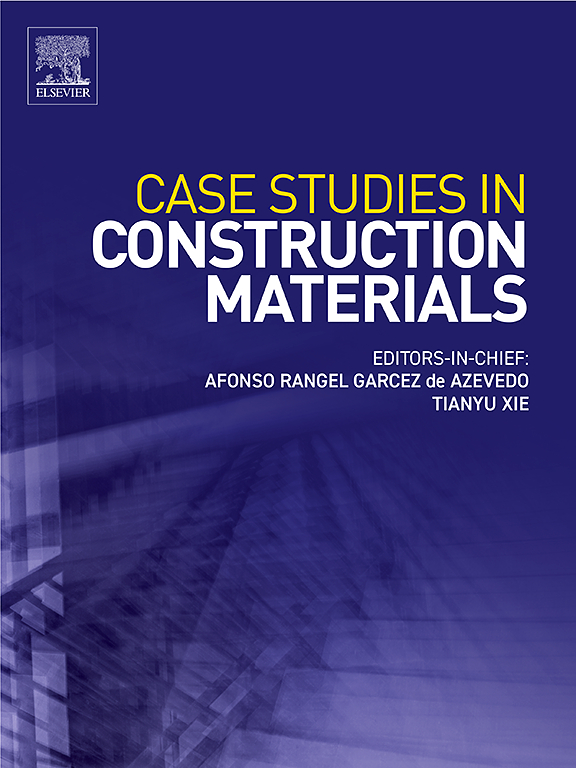Mechanical properties and microstructure of low carbon high-strength engineered cementitious composites with supplementary cementitious material
IF 6.5
2区 工程技术
Q1 CONSTRUCTION & BUILDING TECHNOLOGY
引用次数: 0
Abstract
The carbon emissions associated with concrete production remain a significant unresolved issue. One effective approach to mitigate this problem is to partially substitute cement with supplementary cementitious materials. The aim of the present study was to develop low-carbon, high-strength Engineered Cementitious Composites (HSECC) by incorporating low-hydration active solid waste in the form of coal gangue powder. To investigate the mechanical properties and underlying microscopic mechanisms of these composites, comprehensive testing was conducted, including assessments of compressive strength, tensile strength, single-crack tensile behaviour, three-point flexural performance, and scanning electron microscopy. The test results reveal that the integrity of the damaged compressive specimen was high. Compared with the test group without coal gangue powder, the incorporation of coal gangue powder significantly reduced the compressive strength, decreasing by 27.2 % and 32.5 %, respectively. The tensile strain hardening phenomenon appeared in all experimental groups. The inclusion of an optimal amount of coal gangue powder enhanced the tensile strain capacity, with the maximum tensile strain capacity reaching 4.15 %. Increasing fibre length substantially reduced crack width; for instance, the crack width in the 18 mm fibre test group was 31μm, which is only 33.6 % of the crack width observed in the 12 mm fibre group. Additionally, the incorporation of coal gangue powder significantly contributed to the reduction of crack width. In the context of embodied energy and embodied carbon in HSECC, PVA fibres and cement were found to be the primary contributors. Substituting a portion of the cement with coal gangue powder and silica powder significantly reduced both embodied energy and embodied carbon. The present study provides a novel utilisation method for coal gangue, a solid waste byproduct, which significantly mitigates its environmental impact. Additionally, the high-strength ECC produced using exclusively local materials demonstrates potential for broader implementation, particularly in applications such as concrete for bridge expansion joint anchorage zones and seismic retrofitting of external masonry walls.
添加胶凝材料的低碳高强工程胶凝复合材料的力学性能和微观结构
与混凝土生产相关的碳排放仍然是一个悬而未决的重大问题。缓解这一问题的一种有效方法是用补充胶凝材料部分替代水泥。本研究的目的是通过以煤矸石粉的形式加入低水化活性固体废物来开发低碳,高强度的工程胶凝复合材料(HSECC)。为了研究这些复合材料的力学性能和潜在的微观机制,进行了全面的测试,包括抗压强度、抗拉强度、单裂纹拉伸行为、三点弯曲性能和扫描电子显微镜的评估。试验结果表明,损伤压缩试样的完整性较高。与未添加煤矸石粉的试验组相比,煤矸石粉的掺入显著降低了抗压强度,分别降低了27.2 %和32.5 %。各实验组均出现拉伸应变硬化现象。煤矸石粉掺入最佳量后,拉伸应变能力增强,最大拉伸应变能力达到4.15 %。增加纤维长度可显著减小裂缝宽度;例如,18 mm纤维组的裂缝宽度为31μm,仅为12 mm纤维组裂缝宽度的33.6% %。此外,煤矸石粉的掺入对裂缝宽度的减小有显著的促进作用。在HSECC的隐含能量和隐含碳的背景下,PVA纤维和水泥被发现是主要贡献者。煤矸石粉和硅粉替代部分水泥,显著降低了蕴含能量和蕴含碳。本研究为煤矸石这一固体废物副产品提供了一种新的利用方法,大大减轻了其对环境的影响。此外,仅使用当地材料生产的高强度ECC具有更广泛的应用潜力,特别是在桥梁伸缩缝锚固区的混凝土和外部砌体墙的抗震改造等应用中。
本文章由计算机程序翻译,如有差异,请以英文原文为准。
求助全文
约1分钟内获得全文
求助全文
来源期刊

Case Studies in Construction Materials
Multiple-
CiteScore
7.60
自引率
19.40%
发文量
842
审稿时长
63 days
期刊介绍:
Case Studies in Construction Materials provides a forum for the rapid publication of short, structured Case Studies on construction materials. In addition, the journal also publishes related Short Communications, Full length research article and Comprehensive review papers (by invitation).
The journal will provide an essential compendium of case studies for practicing engineers, designers, researchers and other practitioners who are interested in all aspects construction materials. The journal will publish new and novel case studies, but will also provide a forum for the publication of high quality descriptions of classic construction material problems and solutions.
 求助内容:
求助内容: 应助结果提醒方式:
应助结果提醒方式:


